Post-Holiday Marketing Strategies: Preparing Your Shopify Store for 2026
The holiday season is the biggest shopping season of the year. From Black Friday and Cyber Monday through Christmas and New Year’s, shoppers shop the most during this time of year.
For many Shopify stores, it’s the period when sales skyrocket due to holiday promotions, holiday deals, and creative holiday marketing campaigns.
But here’s the thing: once the rush is over, the work isn’t done. The weeks after the holidays are just as important. That’s when post-holiday marketing strategies step in..
They help Shopify brands keep up momentum, manage returns, boost customer engagement, and turn one-time holiday shoppers into loyal fans.
In this blog, we’ll understand why post-holiday marketing strategies are important, the exact steps to follow, and how you can prepare your store for long-term success in 2026.
Why Post-Holiday Marketing Strategies Matter for Shopify Brands?
The holidays bring huge traffic, but they also bring big challenges. The average ecommerce return rate was 16.9% in 2024; much higher than that of physical stores. After the holiday season, returns spike even more because people exchange gifts.
Many customers get gift cards as a holiday gift, and most of them redeem them in the first three months of the year. If your store isn’t ready, you’ll miss out.
Abandoned cart emails still perform incredibly well. Industry data shows average open rates around 42.35%, making them one of the most effective marketing campaigns even after the holidays.
All of this means one thing: if you don’t have strong post-holiday marketing strategies, you’ll lose sales, miss out on repeat customers, and waste the hype you built during the shopping season.
Follow these 8 Post-Holiday Marketing Strategies to Prepare Your Shopify Store for 2026
To make the most of the momentum from the holiday season, implement these proven strategies that help your Shopify store retain customers, boost sales, and set the stage for a successful 2026.
1. Manage Returns with Care
The reality of holiday sales is simple: a lot of those products will come back. Maybe a sweater didn’t fit, or someone received two of the same holiday gift. Whatever the reason, returns are part of the game.
How to handle it:
- Add a clear returns policy on your product pages so shoppers know what to expect.
- Offer a self-service returns portal (easy to set up in Shopify). This reduces back-and-forth emails and saves time for your team.
- Turn a return into a new sale. For example, instead of giving cash refunds, offer store credit with a limited-time offer, creating a sense of urgency.
By managing returns well, you not only protect your margins but also keep customer engagement positive. A smooth returns process can make someone come back, even after sending an item back.
2. Use Gift Cards to Boost Post-Holiday Sales
Gift cards are one of the easiest wins in post-holiday marketing strategies. Think about it: millions of people receive them during the holiday season, and most want to use them quickly.
What to do:
- Run a gift card redemption campaign in January. Use email and social media to remind customers to use their balance.
- Upsell during redemption. For example, “Use your $50 gift card today and get free shipping on orders over $75.”
- Send balance reminder emails; a gentle nudge can drive them back to your store.
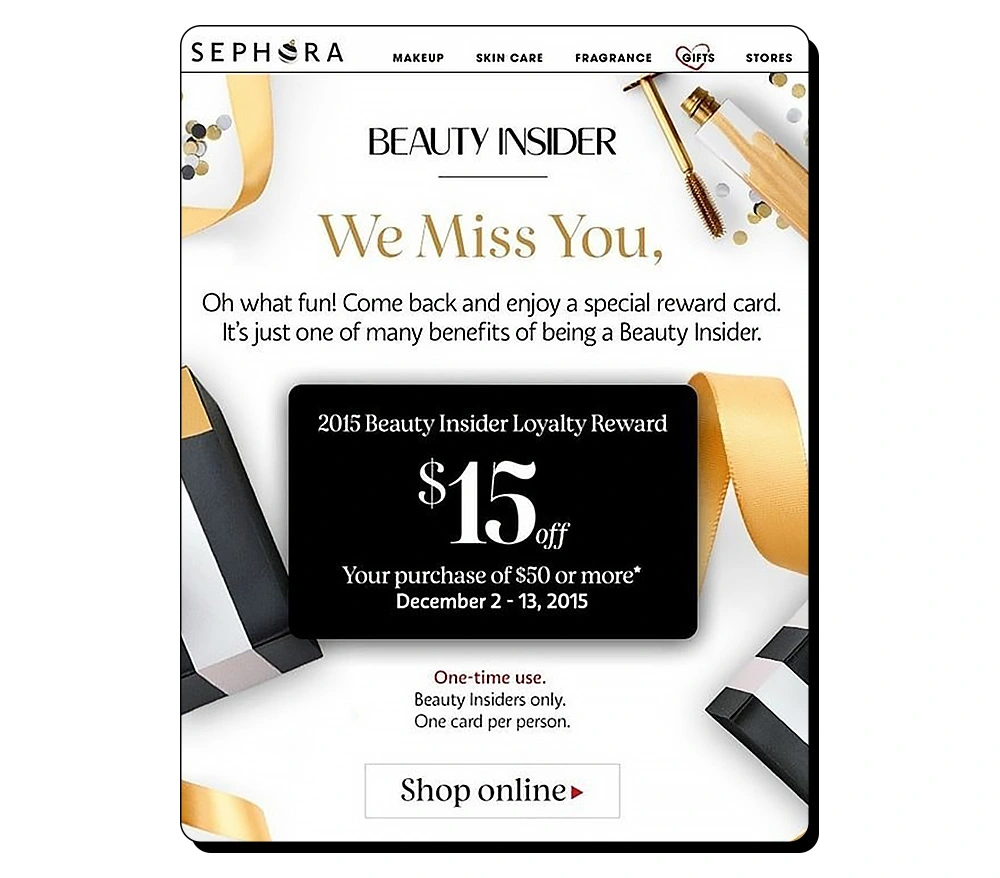
This is also a great moment to introduce customers to new collections or seasonal holiday themes like “New Year Refresh.”
Also read: How to Make the Most of Small Business Saturday for Your Shopify Store?
3. Turn First-Time Holiday Shoppers Into Repeat Customers
The biggest mistake Shopify brands make? Treating holiday shoppers like one-time buyers.
In reality, these customers are valuable. You already paid for the ad or campaign that brought them in during holiday marketing campaigns. Now, with the right holiday marketing strategy, you can keep them coming back all year.
Try this:
Send a welcome flow with three simple emails:
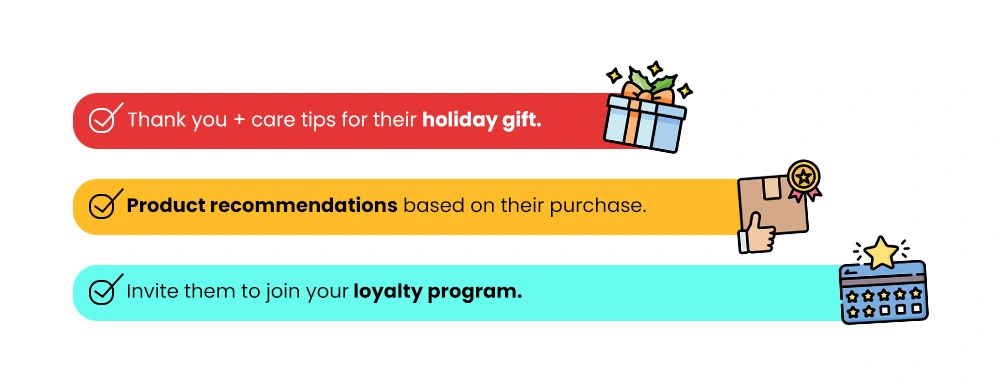
- Offer a VIP incentive in January, like double loyalty points or early access to your next launch.
- Use reviews and social proof from the best holiday advertising campaigns to show trust and build confidence.
This way, post-holiday marketing strategies don’t just boost sales; they build lifetime value.
4. Clear Inventory Without Losing Profit
After the holiday shopping rush, many Shopify stores end up with extra stock. Instead of deep discounts that hurt your brand, smart holiday marketing strategies can help you move products with style.
Smart tactics:
- Bundle slow movers with bestsellers. Example: “Buy our best-selling hoodie and get a scarf for 40% off.”
- Use holiday themes like “Fresh Start January” to position clearance as a positive reset.
- Create urgency with countdown timers or limited-time offers on your site.
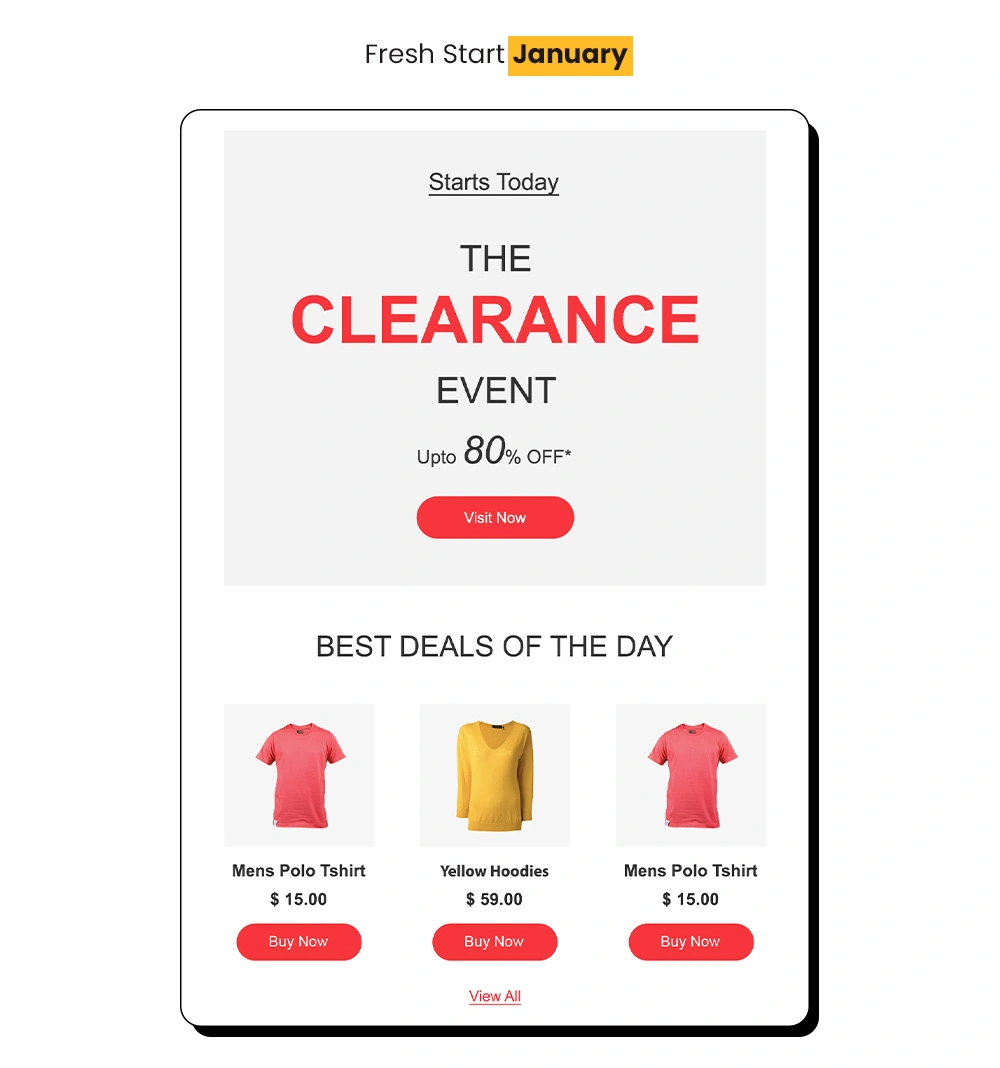
Remember, holiday promotions don’t end with December 25th. They simply shift into new messaging.
Click here to read: How Shopify Brands Can Turn One Day Into Long-Term Sales on National Free Shipping Day?
5. Refresh Your Marketing Campaigns for the New Year
Shoppers are bombarded with ads in December. By January, they’re tired of seeing Christmas trees and snowflakes.
That’s why refreshing your marketing campaigns is one of the smartest post-holiday marketing strategies.
Here’s how:
- Update creatives with fresh, seasonal holiday themes like “New Year, New You.”
- Retarget visitors who came during Black Friday and Cyber Monday but didn’t purchase.
- Segment your audience:
People who bought during the holiday season → show them upsells.
People who browsed but didn’t buy → tempt them with holiday deals.
With a fresh look and smart targeting, your Shopify marketing dollars go further in the new year.
6. Power Up Email & SMS Flows
Email and SMS remain the backbone of Shopify marketing. And during the holiday season, they perform better than ever.
But don’t stop in December. Keep your flows active as part of your post-holiday marketing strategies.
Key flows to run:
- Abandoned cart series: Add social proof and urgency. These emails are highly effective for bringing customers back and boosting sales.
- Re-engagement campaigns: Remind shoppers why they loved your brand.
- Post-purchase series: Send product care tips, ask for reviews, and invite referrals.
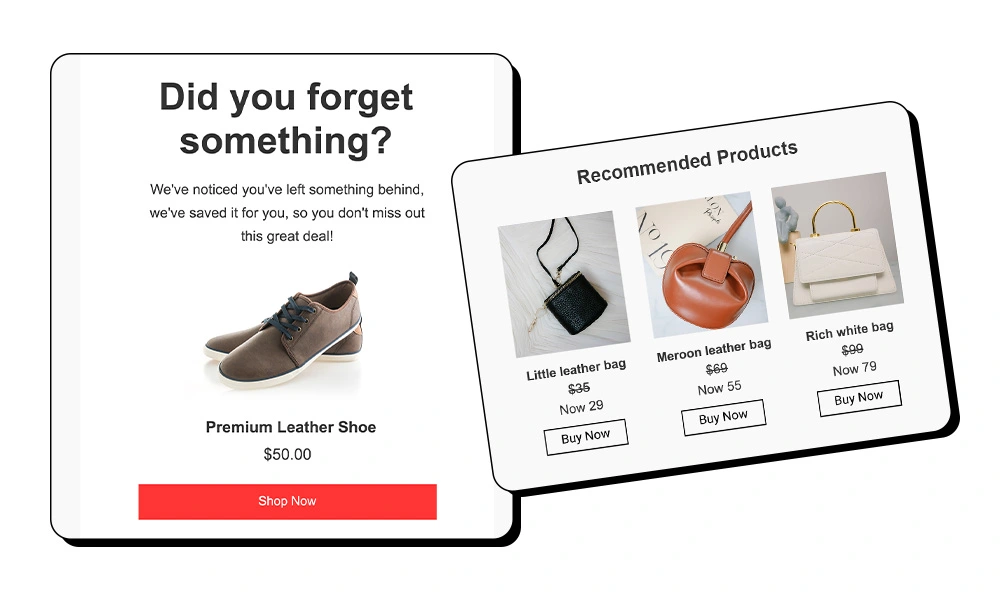
Together, these flows increase customer engagement and build trust far beyond the shopping season.
Ready to Sell More This Shopify Holiday Season? Start With This Marketing Calendar
7. Boost Social Media & UGC
The best content after the holidays? Real people showing off their holiday gifts.
Encourage your buyers to share unboxing videos, photos, or reviews on social media. Then repurpose this user-generated content in your ads and on your product pages.
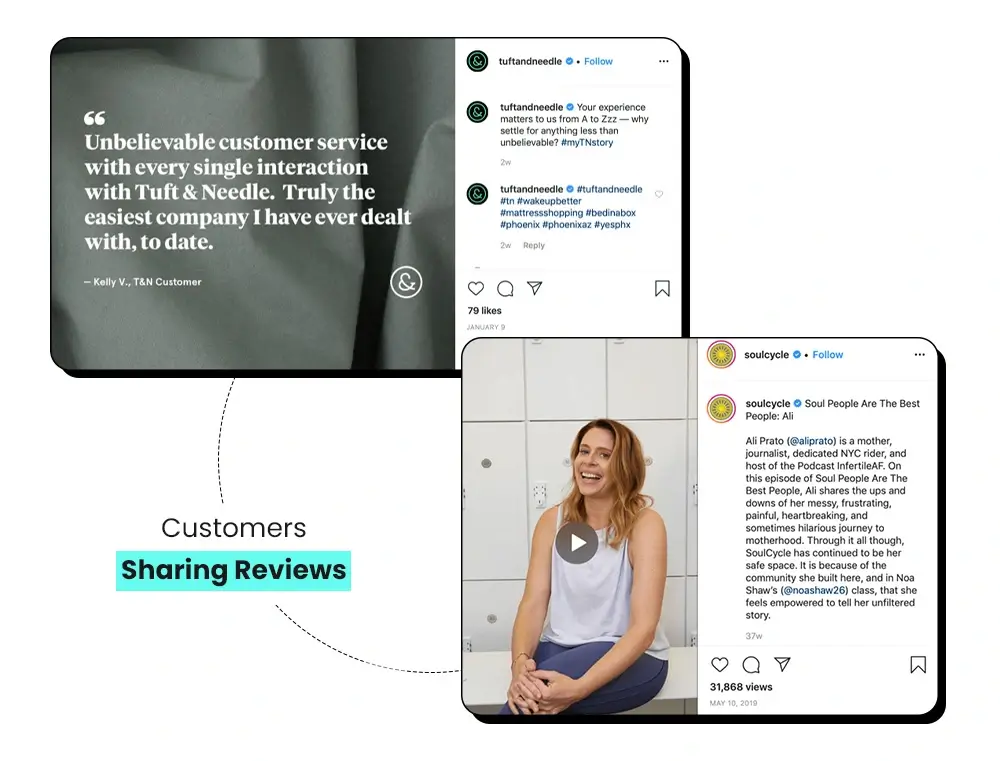
You can also run mini holiday promotions on Instagram or TikTok:
- A photo contest offering limited-time rewards.
- Feature your customers in posts to increase community feel.
This type of festive marketing is authentic and works better than pushing generic ads.
8. Build SEO & Content Momentum for 2026
Don’t let your holiday marketing campaigns fade into silence. Keep publishing and updating content into Q1.
- Write guides like “How to style your winter wardrobe in 2026” or “Best accessories for your New Year look.”
- Update product pages with new keywords beyond just holiday shopping.
- Use your blog to share holiday marketing tips for next season and drive traffic from Google.
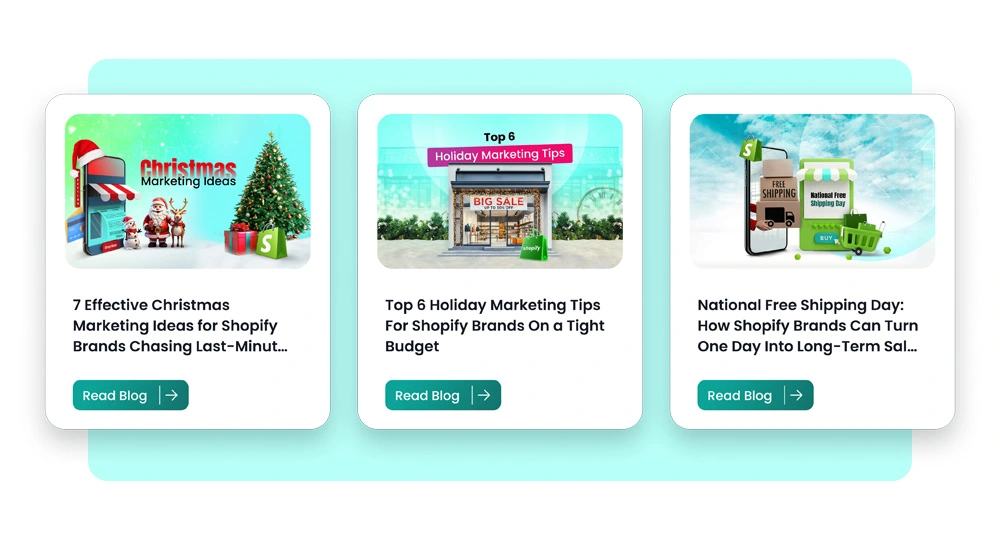
Here’s an example from Mastroke that shows how festive blogs can be crafted to attract and engage their audience.
Remember, SEO takes time, but including it in your post-holiday marketing strategies keeps growth steady throughout the year.
Track the Right Metrics
To know if your post-holiday marketing strategies are really working, you need to measure the right numbers. These data tell you exactly what’s working, what’s not, and where to focus your energy next.
Here are the key metrics Shopify stores should track after the holiday season:
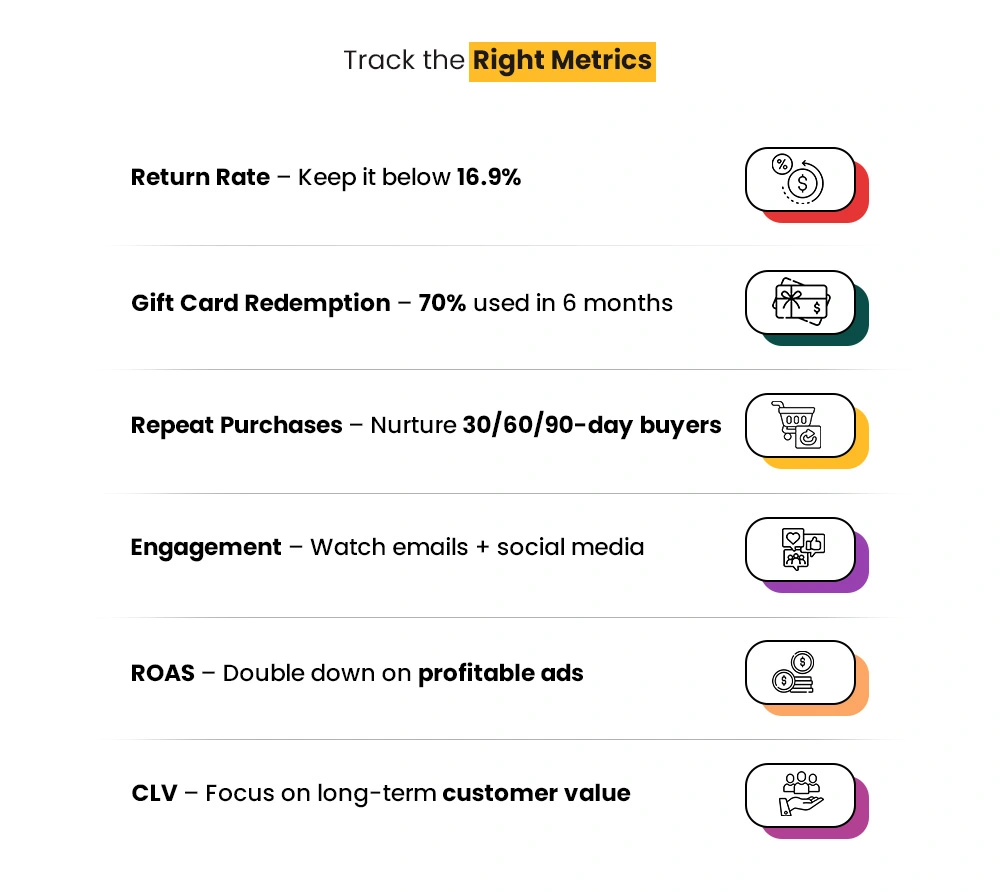
1. Return Rate
The average ecommerce return rate is 16.9% in 2024. Keep yours lower by setting clear expectations on product pages, offering size guides, and communicating shipping timelines.
If returns spike, it’s a red flag that either product descriptions or expectations weren’t clear.
2. Gift Card Redemption
Around 70% of gift card balances are redeemed within the first 6 months, and the majority within 90 days.
Tracking how quickly these balances get used helps forecast revenue flow for Q1 and Q2. A gift card not only guarantees a sale but also often leads to shoppers spending more than the card’s value.
3. Repeat Purchase Rate
Monitor your 30/60/90-day repeat purchase windows. According to Shopify, repeat customers are 9x more valuable than first-time shoppers.
A healthy repeat purchase rate is a sign that your holiday shoppers are turning into loyal buyers.
4. Engagement
Keep an eye on email open rates, click-through rates, and how your social media marketing campaigns perform.
If engagement drops sharply after the holidays, it’s a signal to refresh your messaging and try different holiday themes or limited-time offers to re-engage.
5. ROAS (Return on Ad Spend)
January and February are tricky months, but also full of potential. If your marketing campaigns are driving profitable ROAS, double down on them.
If not, test new channels, like retargeting past holiday shoppers or running post-purchase email flows.
6. Customer Lifetime Value (CLV)
Don’t just focus on one-off holiday sales. Calculate how much your average customer is worth over time.
CLV tells you if your post-holiday promotions are building long-term loyalty or just one-time spikes.
Numbers don’t lie. They highlight where to double down and where to pivot, ensuring that your post-holiday marketing strategies lead to sustained growth rather than short-lived holiday sales.
Bring It All Together
The truth is, post-holiday marketing strategies aren’t just about chasing one more sale. They are about building loyalty, clearing inventory smartly, and creating campaigns that set you up for the entire year.
- Manage returns to keep holiday shoppers happy.
- Turn gift cards into sales drivers.
- Convert one-time buyers into repeat customers with strong Shopify marketing flows.
- Keep your holiday marketing strategy alive with fresh themes, social proof, and SEO.
If done correctly, these steps can make January and February your store’s strongest months.
Conclusion: Set the Tone for 2026 Growth
The holiday season may bring in record-breaking revenue, but the real winners are Shopify brands that know how to turn holiday shoppers into loyal customers.
By applying smart post-holiday marketing strategies, like retargeting, offering personalized deals, and tracking the right performance metrics, you can carry the holiday momentum into the new year.
Remember, this isn’t just about clearing leftover inventory or running last-minute holiday deals. It’s about building deeper customer engagement, improving retention, and preparing your Shopify store for long-term success in 2026 and beyond.
And here’s the best part: You don’t have to do it alone. At Mastroke, we’re a Shopify marketing agency that specializes in helping Shopify stores scale smarter.
Whether it’s optimizing your product pages, running the best holiday advertising campaigns, or creating data-driven marketing campaigns, we’ve got you covered.
Ready to turn your festive marketing wins into year-round growth?
Book a call with Mastroke today, and let’s prepare your Shopify brand for 2026 success.
FAQs on Post-Holiday Marketing Strategies
1. What is the best marketing strategy for Shopify?
The best strategy combines email marketing, retargeting ads, and personalized offers. For long-term success, Shopify stores should focus on customer engagement and building repeat purchase campaigns instead of just one-time holiday sales.
2. How to build a Shopify store in 2025?
Start by choosing a niche, setting up your Shopify account, and designing product pages with clear descriptions and high-quality photos.
Add secure payment options, optimize for mobile shopping, and plan strong holiday marketing campaigns to attract traffic.
3. How to put a Shopify store on holiday?
Shopify has a “pause and build” plan where you can temporarily close your store while keeping your data intact. You can also add banners or announcements to let holiday shoppers know about shipping delays or vacation closures.
4. Who is Shopify’s biggest competitor?
Shopify’s biggest competitors include WooCommerce, BigCommerce, and Wix for ecommerce. However, Shopify stands out for its strong app ecosystem, holiday marketing tools, and scalability for growing Shopify brands.
5. Why do so many Shopify stores fail?
Most stores fail due to weak marketing strategies, poor product-market fit, or lack of customer engagement. Success comes from building a strong brand, optimizing product pages, running effective marketing campaigns, and focusing on retention beyond the holiday season.